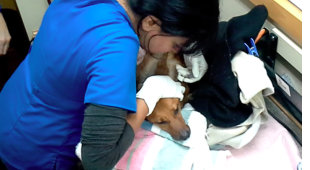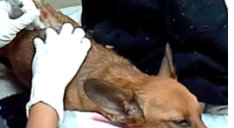
© Copyright Goldendoodles.com 2001. All rights reserved. You may not copy or otherwise use anything on this site without our written permission.
Made with Xara
Introducing Prolotherapy
Slinky is one of my first spinal prolotherapy patients. This extremely sweet and lovable dog has been in excruciating pain for almost a whole year. He had become a fearful dog and most of the time he was trembling just in anticipation of pain. His x-rays showed multiple calcified discs in the spine over the neck and all along the back. An integrative treatment protocol was devised for pain management which included acupuncture, chiropractic, laser therapy, Western and Chinese pain medications. While this helped to alleviate pain to some extent, he still continued to be distressed and cry out with the smallest movement. Pretty soon he had to be carried with the help of a sling keeping his back and neck straight. It was time for intervention at another level. I elected to perform prolotherapy along the entire length of his spine. Injections of dextrose with lidocaine (pain reliever) were injected in multiple anatomical locations of his vertebral column under intra-muscular sedation using strict aseptic protocols. Slinky was provided laser treatment prior to the procedure followed by acupuncture after the procedure. His short term sedation was reversed and he was discharged, still moderately painful. Three days later Slinky had already showed significant improvement. Three weeks later, he ran into my clinic a pain-free happy dog wagging his tail and bouncing around. In my career as an emergency veterinarian, I have found dogs with back pain to be the most challenging cases, both emotionally and medically. I am grateful that I now have another viable non-surgical treatment option to alleviate pain and promote healing. I am proud to be a holistic veterinarian and it is really amazing to practice integrative medicine using my extensive Western medical as well as holistic training. Thank you to Dr. Barb Fehlau and Dr. Marlene Smith for inspiring me.Dr. Radhika Rajagopal,
Phoenix Rising Veterinary CareProlotherapy
Chronic pain from injury to tendons and ligaments are a common problem in the world of small animals (dogs and cats). Mostly, we call these soft tissue injuries and manage them with non-steroidal anti-inflammatories and rest. The tendons and ligaments are usually strong bands of connective tissue but they are poorly supplied with blood vessels. After injury, the healing is incomplete therefore they become weaker and are a source of constant pain. Tendons and ligaments are weakest where they join the bone therefore very prone to injury. Damage to ligaments and tendons are also very painful as they contain the highest receptors for pain next to the outer lining of the bone called the periosteum. Damage to tendons and ligaments also causes loose joints, the body tries to compensate by forming calcifications in these areas leading to arthritis / osteo-arthritis. When tendons are completely ruptured, surgery is the best option I recommend. However for a partial tear of the ligament as in the cranial cruciate ligament or if the client cannot afford surgical intervention, I offer the option of prolotherapy. Prolotherapy involves injection of sterile solutions into tendons or ligaments or joints which has the following effects: It increases collagen formation, it triggers the release of growth factors, It causes local stem cells to proliferate and differentiate into the cells necessary for healing. The prolotherapy injection solutions can include dextrose, vitamins and homeopathic solutions. A small quantity of local anesthetic is included to reduce the immediate discomfort of the injection, and prevent “wind-up” pain, which occurs when nerve cells are stimulated and continue signalling pain even when the source of injury is gone. The healing effect is a graded, controlled reaction producing repair of weak and damaged connective tissue. When properly applied, prolotherapy does not induce scar formation. The bonds in the connective tissue are stronger and healthier, and the tissue is thicker than before treatment. With each treatment, tissues continue to strengthen until the healing is complete and the pain resolved. Joint laxity decreases due to a strengthening and tightening of the treated tendons and ligaments. This reduces or eliminates pain from muscle spasms and also reduces the need for the body to produce excess bony tissue to assist stabilization, as occurs in osteoarthritis. Since the injections need to be placed with great accuracy, and may cause temporary discomfort, most dogs and cats will require a sedative for the procedure, and some may need a short general anaesthetic. The typical hospital stay is half a day. The injections can be placed into multiple locations at one session, and usually a series of three to five sessions, two to four weeks apart, is required. Any injection carries with it a small risk of infection, but this is rare in prolotherapy, as rare as in acupuncture and minimized by the use of strict sterile techniques. All prolotherapy solutions are sterile materials labelled for injection. Non-steroidal anti-inflammatory medications such as Rimadyl, Deramaxx, Metacam and aspirin should not be used during prolotherapy treatments because they stop the release of the growth factors essential to the therapy’s effectiveness. It is not usually necessary to use pain medication for more than a few days after the treatment. Ice and rest provide comfort in the first few days, then heat, stretching and passive range of motion exercises are added. Rehabilitation exercises to help strengthen weakened muscles are also often used to support the healing process.


Goldendoodles.com


The information contained on this site is in no way intended to replace that of proper veterinary advice, diagnosis or treatment.
It is meant to provide resource, so that we can better understand canine health related issues.

© Copyright Goldendoodles.com 2001. All rights reserved. You may not
copy or otherwise use anything on this site without our written permission
Introducing
Prolotherapy
Slinky is one of my first spinal prolotherapy patients. This extremely sweet and lovable dog has been in excruciating pain for almost a whole year. He had become a fearful dog and most of the time he was trembling just in anticipation of pain. His x-rays showed multiple calcified discs in the spine over the neck and all along the back. An integrative treatment protocol was devised for pain management which included acupuncture, chiropractic, laser therapy, Western and Chinese pain medications. While this helped to alleviate pain to some extent, he still continued to be distressed and cry out with the smallest movement. Pretty soon he had to be carried with the help of a sling keeping his back and neck straight. It was time for intervention at another level. I elected to perform prolotherapy along the entire length of his spine. Injections of dextrose with lidocaine (pain reliever) were injected in multiple anatomical locations of his vertebral column under intra-muscular sedation using strict aseptic protocols. Slinky was provided laser treatment prior to the procedure followed by acupuncture after the procedure. His short term sedation was reversed and he was discharged, still moderately painful. Three days later Slinky had already showed significant improvement. Three weeks later, he ran into my clinic a pain-free happy dog wagging his tail and bouncing around. In my career as an emergency veterinarian, I have found dogs with back pain to be the most challenging cases, both emotionally and medically. I am grateful that I now have another viable non-surgical treatment option to alleviate pain and promote healing. I am proud to be a holistic veterinarian and it is really amazing to practice integrative medicine using my extensive Western medical as well as holistic training. Thank you to Dr. Barb Fehlau and Dr. Marlene Smith for inspiring me.Dr. Radhika Rajagopal,
Phoenix Rising Veterinary CareProlotherapy
Chronic pain from injury to tendons and ligaments are a common problem in the world of small animals (dogs and cats). Mostly, we call these soft tissue injuries and manage them with non-steroidal anti-inflammatories and rest. The tendons and ligaments are usually strong bands of connective tissue but they are poorly supplied with blood vessels. After injury, the healing is incomplete therefore they become weaker and are a source of constant pain. Tendons and ligaments are weakest where they join the bone therefore very prone to injury. Damage to ligaments and tendons are also very painful as they contain the highest receptors for pain next to the outer lining of the bone called the periosteum. Damage to tendons and ligaments also causes loose joints, the body tries to compensate by forming calcifications in these areas leading to arthritis / osteo-arthritis. When tendons are completely ruptured, surgery is the best option I recommend. However for a partial tear of the ligament as in the cranial cruciate ligament or if the client cannot afford surgical intervention, I offer the option of prolotherapy. Prolotherapy involves injection of sterile solutions into tendons or ligaments or joints which has the following effects: It increases collagen formation, it triggers the release of growth factors, It causes local stem cells to proliferate and differentiate into the cells necessary for healing. The prolotherapy injection solutions can include dextrose, vitamins and homeopathic solutions. A small quantity of local anesthetic is included to reduce the immediate discomfort of the injection, and prevent “wind-up” pain, which occurs when nerve cells are stimulated and continue signalling pain even when the source of injury is gone. The healing effect is a graded, controlled reaction producing repair of weak and damaged connective tissue. When properly applied, prolotherapy does not induce scar formation. The bonds in the connective tissue are stronger and healthier, and the tissue is thicker than before treatment. With each treatment, tissues continue to strengthen until the healing is complete and the pain resolved. Joint laxity decreases due to a strengthening and tightening of the treated tendons and ligaments. This reduces or eliminates pain from muscle spasms and also reduces the need for the body to produce excess bony tissue to assist stabilization, as occurs in osteoarthritis. Since the injections need to be placed with great accuracy, and may cause temporary discomfort, most dogs and cats will require a sedative for the procedure, and some may need a short general anaesthetic. The typical hospital stay is half a day. The injections can be placed into multiple locations at one session, and usually a series of three to five sessions, two to four weeks apart, is required. Any injection carries with it a small risk of infection, but this is rare in prolotherapy, as rare as in acupuncture and minimized by the use of strict sterile techniques. All prolotherapy solutions are sterile materials labelled for injection. Non-steroidal anti-inflammatory medications such as Rimadyl, Deramaxx, Metacam and aspirin should not be used during prolotherapy treatments because they stop the release of the growth factors essential to the therapy’s effectiveness. It is not usually necessary to use pain medication for more than a few days after the treatment. Ice and rest provide comfort in the first few days, then heat, stretching and passive range of motion exercises are added. Rehabilitation exercises to help strengthen weakened muscles are also often used to support the healing process.

Veterinary articles for the
informed dog owner
Dr. Radhika Rajagopal
1777 Riverside Lane
Courtenay, BC V9N 9W2
Telephone: +1 250-338-2316
The information contained on this site is in no way intended to
replace that of proper veterinary advice, diagnosis or treatment.
It is meant to provide resource, so that we can better understand
canine health related issues.

























